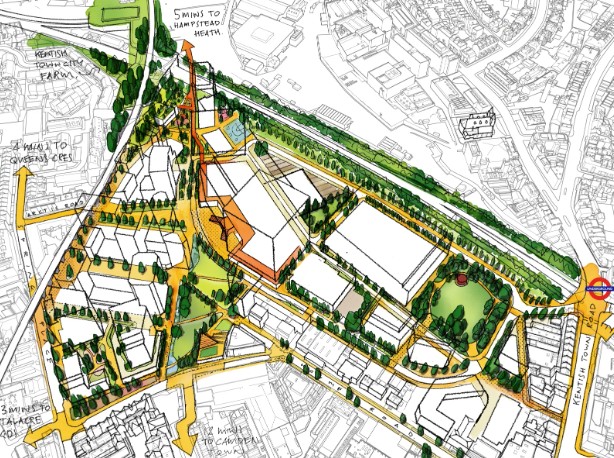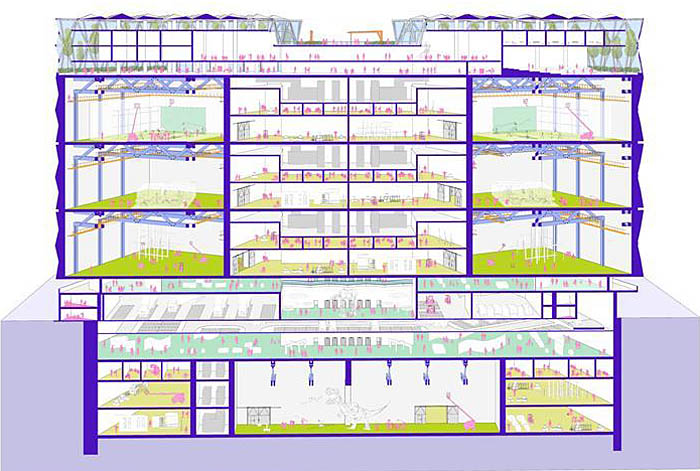Please note that this website is run on a non-profit basis for educational and research purposes. Images are credited with their respective copyright holders where they are known. You may not copy any image for commercial purposes. Please do not ask me for permission to use any images – that permission is not mine to give. If you are the copyright holder for an image and wish it to be removed, please contact me via the form at the foot of the page and I will of course be happy to do so. Also, if you are the owner of an uncredited image and wish to be named, again please contact me and I’ll happily add that information.
from 2029?

Yoo Capital is a privately-held real estate investment firm founded in 2010, based in London. They focus on large-scale projects across the UK, especially in London, and have invested over £2bn in various schemes. They are known particularly for developing spaces that support the arts, creative industries and hospitality sectors.
In April 2023 they announced plans for one of the firm’s most ambitious developments to date: Camden Film Quarter. According to their website:
Working with Camden Council, and consulting with local residents, local businesses and community groups at every stage of the project, Yoo Capital’s vision is to build on the success of the British creative industries by providing vital space for the sector to grow in central London and by attracting world-class creative talent to the capital.

In October 2025 architects SPPARC revealed their plans for the new scheme. The redevelopment of the land to the west of Kentish Town, which currently houses the Holmes Road Depot and the Regis Road Recycling Centre, will deliver a ‘Creative Quarter’ – a hub for film, creative and cultural industries, providing thousands of jobs. The masterplan also outlines proposals for more than 1,000 mixed tenure homes, with Yoo Capital stating that 50 per cent of the housing will be affordable. The quarter will be located to the north of Regis Road, opening up an underused site and improving access to the area through a new network of pedestrian and cycle paths, which will run through additional parks and green spaces. A new cycle bridge crossing the railway line will shorten the journey between Kentish Town and Hampstead Heath.

image thanks to Yoo Capital and SPPARC
Initially, stories in local newspapers stated that there would be 11 sound stages while more recent reports quote architect Trevor Morriss who said that there needed to be 8 sound stages – each of ‘20,000 square metres’. Frankly, that cannot possibly be correct so I think he probably said 20,000 square feet, which is a much more normal size for a sound stage. In any case, they will be stacked above each other, allowing campus space to be maximised. There will also be post production suites, editing facilities and ‘creative collaboration spaces’.
The residential area sits adjacent to the production stages and is planned to include galleries, shops, restaurants and leisure facilities. The architects claim that residents will be protected from the noise of film-making by ‘cutting-edge’ sound insulation technology. To be fair, Riverside studios in Hammersmith have luxury flats built on top of the TV studios and the sound insulation there is so good that very loud music can be performed without disturbing the neighbours.
‘A masonry façade will feature origami-style outdents that react in reverse to the indent sound cushioning on the interiors of six upper-level sound stages’, said the company. The facility will be easily scalable to meet the evolving demands of a broad range of production needs across film, TV and digital media. They claim that these studios will be the first built on multi levels in Europe – although readers of this website will know that Lime Grove Studios beat them to that distinction back in 1932.
According to the developers, the city centre location aims to challenge ‘the status quo of film studios as industrial sheds in remote locations.’ The intention is that the people working in the studios will travel on foot, via public transport. One assumes that the architects will have taken into account deliveries of scenery, props, costumes, lights, grip gear, rigging gear etc. There will need to be plenty of space for large trucks and vans to park and unload – especially if all 8 stages are in use. I have not seen any detailed plans but one hopes the sound stages will be serviced by several very large, extremely reliable lifts.
In all the various reports about this scheme, I can find no reference to workshops. All the successful film studios west of London, including Pinewood, Shepperton, Leavesden, Shinfield, Sky Elstree, Longcross, Bray etc. have a similar area of workshop space to sound stage space. Workshops are used to build scenery, make props, make and store costumes, create special effects, store and maintain lighting kit, store and prepare rigging gear, act as dressing rooms and holding areas for background artists (extras) etc. These would all provide much needed jobs for local people who might otherwise not consider that the film industry had anything to offer them employment-wise. Also, this is a significant factor when a production company is choosing a studio in which to make their film or TV drama. Let us hope that when the details of the scheme are worked out, these can be included – or maybe this has already been considered and has not been mentioned.
Two film and television schools are proposed within an on-site education hub facing a new park. This would include a new home for the London Screen Academy, a specialist sixth form college established in 2019 that offers vocational and academic courses for students aged 16 to 19 pursuing careers in film and television production. According to press reports, the plans include a Museum of Film & Television as well as studio tours – one assumes when no filming is taking place. All production companies are very secretive about the films and TV dramas they are making, with actors and crew usually having to sign NDAs.
The developer is expected to apply for planning permission in November 2025. The vision for Camden Film Quarter was adopted by Camden Council as part of the Regis Road Area Guidance in March 2025 so the council appears to be welcoming this proposal. Detailed examination of the plans by local councillors will probably take place early in 2026. To be fair, there does seem to be a level of opposition from local residents. The area is currently occupied by a recycling plant, which will have to be relocated to another site in the borough. Inevitably, people are also questioning how genuinely affordable the ‘affordable’ housing will be and what will happen to the small businesses currently based in the area.
It is a major development so if planning permission is swiftly passed and work begins later in 2026, we might expect the facilities to be available from around 2029.
